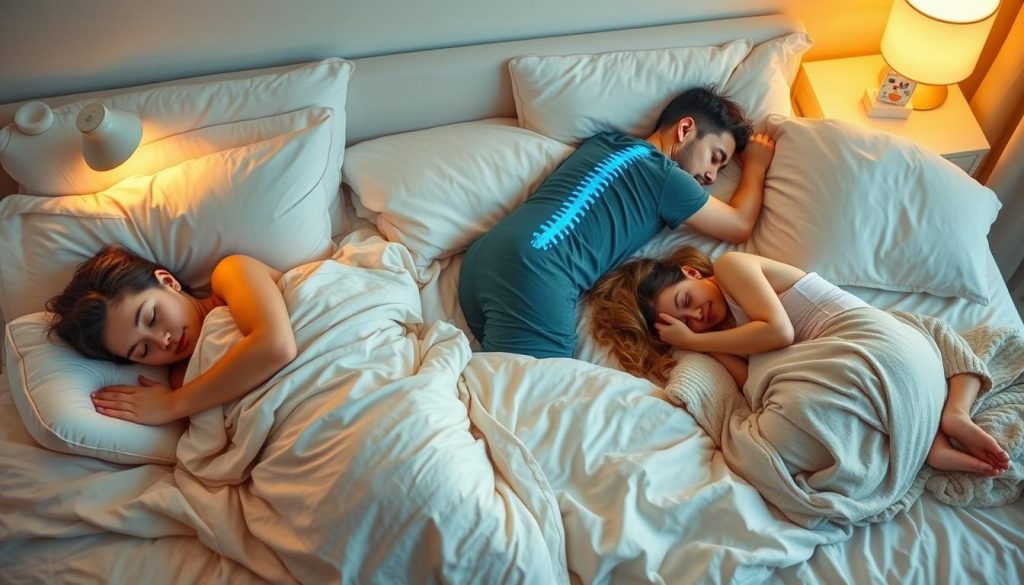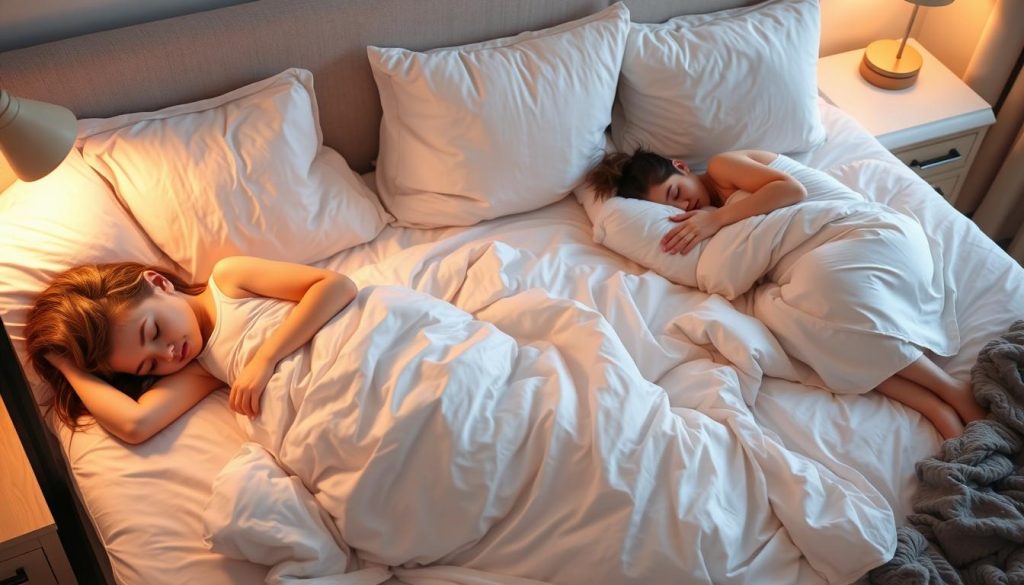Discovering optimal sleep positions is like finding a secret to feeling refreshed. Every night, we look for a good night’s sleep. But, the secret might be in the best sleeping positions.
Choosing healthy sleeping positions improves our sleep and boosts our health. It makes mornings full of energy and life.
Exploring sleep positions reveals their big impact on our health. Waking up feeling good is possible. Our spine, breathing, and mind all connect to our sleep position.
Let’s learn how the right sleep positions can change our nights and days for the better.
The Importance of Choosing the Right Bed Sleeping Positions
Knowing the best correct sleeping positions is key to more than just a good night’s sleep. It’s about keeping your body healthy and working well. How you sleep can greatly affect your spinal alignment during sleep, which is vital for your health. The Mayo Clinic says good sleep boosts your brain and keeps your body strong over time.
Looking for the right proper sleep posture is more than just avoiding back pain. A spine that’s aligned right can help with things like blood flow and digestion. The National Sleep Foundation also points out that bad sleep posture can mess up your sleep. This can make you feel tired and less productive during the day.
- Reduction of lower back pain
- Enhanced breathing during sleep
- Improved circulation and heart health
- Better digestion through the night
These benefits show why finding your correct sleeping positions is so important. It’s not just about avoiding pain. It’s about choosing a lifestyle that makes you feel alive and well. Making small changes to your sleep habits can make a big difference in your life and health. Remember, the right position might just be a simple change away.
Understanding Sleep Posture and Its Effects on Health
It’s important to know how your sleep position affects your health. Sleep posture impacts not just your sleep quality but also your physical health. The American Chiropractic Association says a proper sleep posture keeps your body aligned. This can prevent pain and improve how your body functions.
What Is Sleep Posture?
Sleep posture is how you rest during sleep. You can sleep on your back, side, or stomach. Each position affects your health differently. Keeping your spine, neck, and hips aligned is key for good health and function.
Health Benefits of Proper Sleep Posture
Good sleep posture offers many health benefits. Harvard Medical School lists several key advantages:
- Reduction in back and neck pain
- Enhanced spinal alignment which supports the body’s natural curves
- Improved digestion
- Decreased risk of sleep apnea
- Better circulation and oxygen flow
Choosing the right sleep posture can greatly improve your health. It’s a key part of a healthy lifestyle.

Bed Sleeping Positions for Back Pain Relief
Finding the best sleeping positions is key for better sleep and spinal health. The fetal position is often recommended by doctors, like those at Spine-Health. It can greatly reduce back pain. Keeping your spine aligned while sleeping is also important for a good night’s sleep.
The Fetal Position: A Natural Pain Reliever
The fetal position is great for people with herniated discs or lower back pain. It curls the torso towards the knees, which helps the vertebrae space out. This reduces pressure on the discs. The Cleveland Clinic says sleeping on your left side in this position can be even more beneficial.
Maintaining Spinal Alignment During Sleep
Keeping your spine aligned while sleeping is essential. It prevents muscle strain and keeps your backbone from being stressed. A supportive mattress and pillow can greatly improve your sleep and reduce pain. Here’s how to keep your spine aligned:
| Component | Role in Spinal Alignment |
|---|---|
| Supportive Mattress | Supports the natural curve of the spine |
| Memory Foam Pillow | Elevates the head to align the neck with the rest of the spine |
| Adjustable Bed Base | Allows for the spine to stay level throughout the night |
Using the best sleeping positions and keeping your spine aligned can help with back pain. It can also prevent future back problems. Adjusting your sleep setup to fit these positions can make your sleep more restful and healing.
Bed Sleeping Positions to Reduce Snoring
Looking into different bed sleeping positions can make a big difference in how well you sleep and reduce snoring. Focusing on the best positions can help you find ways to fight snoring. This is based on advice from Sleep.org and the American Sleep Association.
Why Side Sleeping Can Help
Side sleeping is known for being very comfortable and can help with snoring. It stops the tongue from blocking the airway, which is a common snoring cause. Sleep.org studies show that side sleeping not only cuts down on snoring but also improves sleep quality and oxygen levels.
The Impact of Pillows on Snoring
The right pillows are key in fighting snoring. The American Sleep Association says using an adjustable pillow to lift the head can help. Choosing the right pillows and placing them correctly can greatly affect airflow and neck alignment, which in turn affects snoring.
| Sleeping Position | Effectiveness in Reducing Snoring | Notes |
|---|---|---|
| Side Sleeping | Highly Effective | Reduces airway obstruction |
| Back Sleeping with Elevated Head | Moderately Effective | May cause tongue fall-back depending on elevation |
| Stomach Sleeping | Less Effective | Can strain the neck, not recommended for everyone |
Optimizing Your Sleep Environment for Better Rest
Creating the perfect sleep space is key to getting good rest. It’s about the room’s temperature, mattress, and lighting. We’ll show you how to adjust these to help you sleep better.
Room temperature is often ignored but it’s very important. The Sleep Foundation says to keep it cool, around 60 to 67 degrees Fahrenheit. This helps your body regulate its temperature while you sleep.
- The right mattress supports your spine and makes sleeping comfortable. Memory foam and hybrid mattresses are great because they mold to your body and reduce pressure.
- Lighting affects our sleep cycle. Dimming lights an hour before bed tells your body it’s time to sleep, helping you fall asleep faster.
| Feature | Recommended Settings | Benefits |
|---|---|---|
| Room Temperature | 60-67°F | Supports body’s thermoregulation |
| Lighting | Low before bedtime | Enhances circadian rhythm |
| Bedding | High-quality, breathable materials | Maximizes comfort, maintains body temperature |
Adjusting your environment to these settings can really boost your sleep quality. It ensures your sleep positions are not only comfy but also good for your health.
Best Sleeping Positions for Pregnant Women
Pregnancy changes a woman’s body in many ways, including sleep. Finding the right sleeping positions is key for health and comfort. Side sleeping, on the left side, is best as it improves blood flow and eases back pain.
The Benefits of Side Sleeping During Pregnancy
Side sleeping is great for pregnant women. It helps reduce acid reflux and boosts blood flow to the uterus and fetus. Sleeping on the left side is best because it avoids liver pressure and improves heart function.
Sleeping with Supportive Pillows
Supportive pillows are essential for a good night’s sleep during pregnancy. They can be placed under the stomach, between the knees, and behind the back. These pillows help keep the hips, back, and pelvis aligned, which is important during pregnancy. For more advice, check out the American Pregnancy Association.
| Pillow Type | Benefits | Placement |
|---|---|---|
| Pregnancy Body Pillow | Supports the entire body, reduces back pressure | Along the back or front of the body |
| Wedge Pillow | Elevates the upper or lower body to relieve discomfort | Under the belly or back |
| Knee Pillow | Aligns hips and prevents pain in the pelvic area | Between the knees |
Using the best sleeping positions and supportive pillows greatly improves sleep quality. This not only makes sleeping more comfortable but also keeps the mother and baby healthy. It’s important to make these changes a part of your nightly routine.
Correct Sleeping Positions for Infants and Young Children
Keeping infants safe while they sleep is very important. Following healthy sleeping positions for infants can lower the risk of sudden infant death syndrome (SIDS) and other sleep problems. The American Academy of Pediatrics tells parents and caregivers to keep their babies in the right sleep position.
Putting the infant on their back for every sleep is highly recommended. Many health groups around the world agree on this. It’s the safest position and lowers the risk of sleep-related dangers.
Why Position Matters: The right position helps avoid health risks and supports better breathing and sleep. Sleeping on their back keeps airways open and is safe for infants during their most vulnerable times.
- Always place the infant on their back on a firm sleep surface.
- Avoid soft bedding, pillows, and stuffed toys in the crib to prevent risks of suffocation.
- Consider using a sleep sack as an alternative to blankets to keep the baby warm without covering their face or head.
The rules for correct sleeping positions are simple but very important for keeping children safe while they sleep. Following these guidelines helps ensure healthy sleeping positions for infants as they grow.
Parents should talk to healthcare providers for advice, if their baby seems uncomfortable or has irregular sleep patterns. Knowing and following these safe sleep practices is essential for a safe sleep environment for young children.
How to Transition to Healthy Sleeping Positions
Changing your sleep habits is key for your health. Learning to sleep in healthier positions can improve your sleep quality. It also brings long-term health benefits. We’ll look at effective methods and the role of sleep aids in making this change.
Techniques to Change Your Sleep Habits
Switching to better sleep positions requires habit changes and being mindful of sleep prep. Here are some helpful strategies:
- Start by introducing new sleeping positions slowly. This lets your body adjust without pain.
- Place reminders like notes or posters in your bedroom. They help keep you focused on your new sleep posture.
- Set phone alarms or notifications. They remind you to change positions if you fall back into old habits.
Being consistent and patient is important. It takes time to fully adopt these changes.
Using Sleep Aids to Enhance Comfort
Choosing the right sleep aids can make changing your sleep posture easier and more comfortable. Here are some aids that can help:
- Ergonomic pillows support your neck and back. They’re essential for good sleep posture.
- Adjustable beds can be set to support different sleeping positions. They help reduce pressure on your body.
- Body pillows are great for side sleepers. They help with breathing and keeping your spine aligned.
Using these aids with the recommended techniques helps adjust your sleep habits. This leads to a healthier sleep routine.
Risks Associated with Incorrect Sleeping Positions
It’s important to know how bad sleep posture can hurt your health. Wrong sleeping positions can harm your sleep quality and lead to serious health problems. Sources like WebMD and Johns Hopkins Medicine show the dangers of bad sleeping habits.
The Effects on Sleep Quality
Bad sleep posture can make you wake up a lot and sleep less. This can make you tired during the day, less sharp, and more irritable. It can also cause muscle and joint problems, making it hard to sleep well.
Long-Term Health Consequences
Ignoring good sleep posture can cause long-term health issues. These include chronic back and neck pain, spinal problems, and heart disease risks. It’s key to adopt the right sleeping positions to avoid these problems.
Being aware of the dangers of bad sleep positions and trying to improve can greatly help. It can make your sleep better now and protect your health in the future. Learning from top health sources helps us make better choices for our sleep.
Comfortable Sleeping Positions for Couples
Finding the best sleeping positions for couples can be tricky. But, with some knowledge and flexibility, both partners can get better sleep and a stronger bond.
Looking for the best sleeping positions means considering what each person likes and needs. We’ll look at some comfortable sleeping positions for two that can help couples overcome common issues.
- The Spoon: This classic position has one partner’s back against the other’s stomach. It’s great for those who love being close while sleeping.
- The Loose Spoon: As relationships grow, the spoon position might change. This is okay. It lets both partners have more space while staying connected.
- The Back Kissers: Here, both sleep on their backs with their spines aligned and bottoms touching. It’s comfy and keeps a connection.
- The Nuzzle: One partner rests their head on the other’s chest. It’s very comforting and builds a sense of safety and love.
Trying out different comfortable sleeping positions for two is important. It helps find a balance between rest and closeness. The key is to choose a position that helps both partners sleep well, so they wake up feeling refreshed and ready for the day.
How Sleep Positions Affect Dreams and Sleep Quality
Exploring the impact of how we sleep, we see a strong connection between healthy sleeping positions and better sleep quality. These positions shape our dreams and how well we sleep.
The Link Between Sleep Positions and Dream Recollection
Studies show that certain sleep positions can make dreams more vivid and easy to remember. Side sleeping, for example, is linked to more memorable dreams. In contrast, stomach sleepers often have trouble remembering their dreams, possibly due to poorer sleep quality.
Positional Impact on Sleep Cycles
Sleeping positions also affect our sleep cycles, including the REM phase, where dreams happen. The right sleeping position can lead to longer, uninterrupted REM cycles. This not only improves sleep quality but also makes dreams more intense and detailed.
| Sleep Position | Effect on Dream Recall | Impact on REM Sleep |
|---|---|---|
| Back (Supine) | Increase in dream intensity and recall | Promotes stable and prolonged REM phases |
| Side (Lateral) | Enhanced vividness of dreams | Supports continuous REM sleep |
| Stomach (Prone) | Reduced dream recall | Often disrupts REM cycle |
Customizing Your Bed for Optimal Sleep Positions
Getting a good night’s sleep begins with your bed’s basics. Choosing the right mattress and bedding is key. Let’s explore how these choices can make your sleep better.
Choosing the Right Mattress
Understanding mattress types and their benefits is vital. Consumer Reports says mattress firmness matters for sleep. The best mattress supports your body, keeps your spine straight, and spreads out your weight.
The Role of Bedding in Sleep Comfort
The Sleep Foundation stresses bedding’s role in sleep quality. The right bedding keeps you cool and comfortable all night. Cotton or bamboo sheets are great for breathability. Also, the feel of your sheets and blankets affects your sleep.
| Features | Benefits | Recommended Products |
|---|---|---|
| Memory Foam Mattress | Contours to the body, providing excellent support and reducing pressure points. | Tempur-Pedic |
| Breathable Cotton Sheets | Enhances air circulation, helps control body temperature. | Boll & Branch |
| Moisture-Wicking Bedding | Keeps the sleep surface dry, ideal for those prone to sweating at night. | Sheex |
Bed Sleeping Positions for Those with Sleep Apnea
Finding the best sleeping positions for sleep apnea is key to managing this sleep disorder. Certain positions can cut down on apnea episodes, improving sleep quality and health. Positional therapy is also a helpful treatment. It teaches patients to sleep in ways that keep their airways open for easier breathing.
Positional therapy uses special devices or pillows to keep you in the right sleeping position. This stops you from rolling onto your back, which can make apnea worse.
How Sleeping Positioned Can Influence Apnea Episodes
Sleeping on your back is the worst for sleep apnea. It lets the soft tissues in your throat collapse, blocking your airway. But, sleeping on your side or with your head elevated keeps your airways open. This greatly reduces sleep disruptions and apnea episodes.
Positional Therapy as a Treatment for Sleep Apnea
Positional therapy helps you sleep on your side, which is one of the best sleeping positions for sleep apnea. Regular use of this therapy can lead to long-term benefits. It can make sleep apnea less severe, giving you more restful nights.
| Position | Effectiveness |
|---|---|
| Supine (Back sleeping) | Least effective – Increases apnea episodes |
| Side Sleeping | Highly effective – Reduces apnea episodes |
| Elevated Head | Effective – Aids in keeping airways open |
Evaluating New Sleep Research on Correct Sleeping Positions
The role of healthy sleeping positions is now more important than ever, thanks to new sleep research. This research has changed how we view and improve sleep quality. Studies from the National Institutes of Health and the Sleep Medicine Reviews journal have been key in this shift.
These studies explore the mechanics of sleep and provide advice for better rest. They aim to improve our overall well-being through sleep.
This new sleep research carefully looks at the health effects of different sleeping positions. It separates myths from facts. This focus on facts is leading to better sleep health advice.
| Study | Key Findings | Recommendations |
|---|---|---|
| National Institutes of Health 2023 | Link between spinal alignment and sleep quality | Favor back and side positions to reduce back pain |
| Sleep Medicine Reviews 2023 | Impact of sleep posture on breathing patterns | Avoid stomach sleeping to enhance airway alignment |
Using these healthy sleeping positions can make sleep better right away. It also helps our health in the long run. Doctors are now more focused on science-backed sleep advice, thanks to new sleep research.
This ongoing research in sleep science helps us understand and improve our sleep habits. It gives us the knowledge to make positive changes in our lives.
Expert Suggestions for Proper Sleep Posture
Getting a good night’s sleep is key to feeling rested and healthy, says the American Academy of Sleep Medicine. Sleep experts stress the importance of keeping your spine straight while you sleep. They warn against sleeping on your stomach, as it can put too much pressure on your spine.
Instead, they recommend sleeping on your back or side with the right pillow support. To keep your lower back in its natural curve, place pillows under your knees if you sleep on your back. Or, put them between your legs if you sleep on your side.
The World Association of Sleep Medicine also supports these tips, highlighting the importance of a good mattress. A mattress that’s too soft can cause your body to sink, leading to poor alignment. On the other hand, a mattress that’s too firm can put extra pressure on your joints.
Choosing the right mattress is key to proper sleep posture. It should be comfortable yet supportive, fitting your unique sleeping style and body shape.
Following these expert tips might take some getting used to, but the benefits are worth it. Better sleep quality and fewer aches are just the start. Optimal sleep posture is a cornerstone of a healthy lifestyle.
By listening to the pros, you can turn your sleep into a healing experience. Enjoy the rewards of deep sleep and improved health.
FAQ
Q: What are the best bed sleeping positions for better rest?
A: The best sleeping positions align your spine and reduce pressure points. Sleeping on your back or side is usually best. Avoid stomach sleeping to prevent neck and back strain.
Q: Why is it important to choose the right bed sleeping positions?
A: The right sleeping positions keep your spine aligned and support breathing. They also prevent pain. This leads to better sleep and health.
Q: What is sleep posture and how does it affect health?
A: Sleep posture is how your body is positioned during sleep. The right posture can reduce pain, improve circulation, and breathing. This is good for your overall health.
Q: Are there specific bed sleeping positions that can help relieve back pain?
A: Yes, the fetal position can ease back pain by lessening spine pressure. A pillow between your knees or under your knees can also help keep your spine aligned and relieve pain.
Q: Can bed sleeping positions reduce snoring?
A: Yes, side sleeping can reduce snoring by keeping airways open. Special pillows can also help by elevating your head and reducing snoring.
Q: How should I optimize my sleep environment for better rest?
A: For better sleep, keep your bedroom cool, dark, and quiet. Choose a comfy mattress and pillows that support your sleep position. Avoid electronic devices before bed.
Q: What are the best sleeping positions for pregnant women?
A: Pregnant women should sleep on their left side. Use pillows for back and knee support to increase comfort and sleep quality.
Q: What are the correct sleeping positions for infants and young children?
A: Infants and young children should sleep on their backs on a firm, flat surface. Avoid soft bedding and toys to reduce SIDS risk and ensure safe sleep.
Q: How can I transition to healthy sleeping positions?
A: To transition, be mindful of your sleep posture and use ergonomic pillows. Adapting sleep accessories can also help. Start slow and be patient.
Q: What are the risks associated with incorrect sleeping positions?
A: Wrong sleeping positions can cause poor sleep, pain, and snoring. They may also lead to long-term health problems.
Q: What are comfortable sleeping positions for couples?
A: Couples can sleep comfortably in spooning, back-to-back, or side-by-side positions. Use pillow barriers to define personal space if needed.
Q: How do sleep positions affect dreams and sleep quality?
A: Sleep positions can change your dreams and sleep quality. For example, left-side sleeping might lead to more vivid dreams. Comfortable positions can result in deeper sleep.
Q: How can I customize my bed for optimal sleep positions?
A: Customize your bed by choosing the right mattress firmness and bedding. Opt for breathable, supportive pillows and sheets to enhance comfort.
Q: What are the best sleeping positions for those with sleep apnea?
A: Side sleeping or sleeping at an incline can help those with sleep apnea. Positional therapy can also reduce apnea episodes.
Q: What does new sleep research say about correct sleeping positions?
A: New research supports the importance of correct sleeping positions for spinal alignment, pain prevention, and better sleep. It suggests individual assessments for the best sleep postures.
Q: What do experts suggest for proper sleep posture?
A: Experts recommend a neutral spine position and supportive pillows. Choose a sleep position that aligns with your comfort and health needs. Back sleeping is often advised, but consider individual needs.
Go to the full page to view and submit the form.









